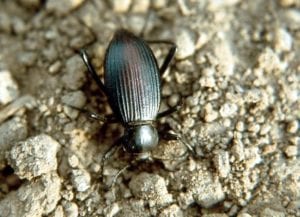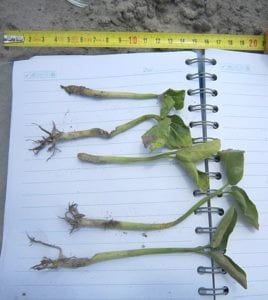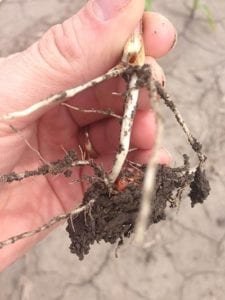By Louis Sutton
Regional Product Manager – Agronomy Lead

False wireworm larvae; look carefully at the back of the worm to see the extra body segment in the false wireworm. Photo courtesy of Kansas State University.
It’s that time of year for issues to start happening to your corn crop now that it is in the ground or soon will be. Two of the pests that you could be seeing this year are Wireworms and False Wireworms. I will cover the differences between them and tell you a quick way of telling them apart without having to send them to a lab or count body parts. Both pests can attack your corn seedlings and reduce stands or stunt plants thus reducing your yields. True wireworms are the larvae of the click beetle, while the false wireworms are the larvae of the darkling beetle, of which there are many types. The wireworm varies in size but is normally about half an inch long while the false wireworm can be up to one inch long. Both can feed on the seed, mesocotyl, and roots of the plants and, if the growing point is below ground, can feed on the growing point.
How do you tell them apart? One way is to count legs, types of legs, and body segments, as well as looking at the antennae or the feeding parts. Another way is to send them to a lab, where they would identify the pest for you. But there is an easier test that is very effective and very simple to do. Hold the worm by the head and gently start squeezing it and see where the excrement comes out of the worm. If it comes out at the very back of the worm, it is a true wireworm. If it comes out on the underside of the worm, close to the end, and there is another body segment passed, then it is a false wireworm. So, why is it important to know the difference between them? Your seed treatment provides very good control of true wireworm, unless your insect pressure is very high, then the pests can overwhelm the insecticide and cause damage. On the other hand, false wireworms are not very well controlled with your seed applied insecticide. So being able to know the difference quickly will allow you to treat the pests and reduce the damage they cause.
It is best to inspect for wireworms and false wireworms early in the day, specifically before 10 a.m. This is because the heat of the day causes the worms to go deeper into the soil. Gently remove clods and loose dirt along two feet of row and about eight inches on each side of the row. Then slowly dig along the seed row and out about two to three inches deep and count the worms you find. I recommend treating the false wireworm if you find two to three worms in this area; make sure you check three to four different locations in your field as there will be many that you may not see due to the incredibly small size of these insects. As small as they are, they can still be causing damage.



